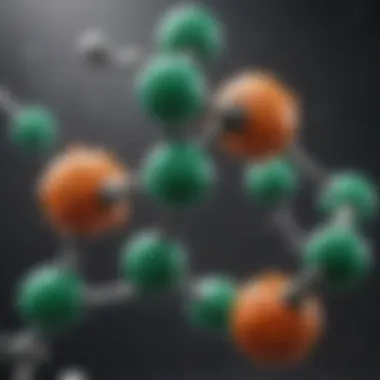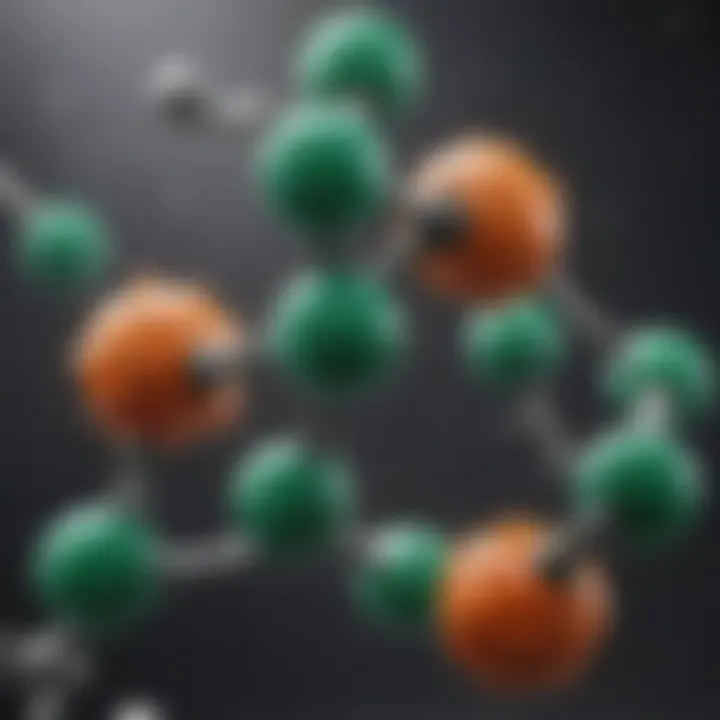Examining QoI Fungicides: Effectiveness and Applications


Intro
In the agricultural world, control of fungal diseases is a constant battle, with practitioners always on the lookout for effective tools. One such innovation is QoI (Quinone Outside Inhibitor) fungicides, a class of chemicals that offers a targeted approach to combating fungal pathogens. Known for their effectiveness and unique mode of action, these fungicides have gained traction in both commercial and residential farming settings. Before diving into the specifics, it’s essential to understand what these products bring to the table and their relevance.
QoI fungicides work by interfering with the mitochondrial respiration of fungi, effectively halting their growth. This unique mechanism makes them not just a quick fix, but a significant player in the ongoing effort to secure yields in various agricultural settings. However, with great power comes great responsibility, as their widespread use has raised alarms regarding the emergence of fungal resistance.
The following sections will dissect the advantages and pitfalls of QoI fungicides, drawing a comprehensive picture of their role in modern agricultural practices.
Prologue to QOI Fungicides
The realm of agriculture and horticulture has never been static, and with the significant pressures of climate change and emerging fungal diseases, the role of effective disease management has gained added importance. Quinone Outside Inhibitor (QOI) fungicides emerged as powerful tools, promising not just disease control but also enhanced crop productivity. These are not mere chemicals; they play a critical role in the complex web of agricultural practice. The effectiveness of these fungicides can often make the difference between a bountiful harvest and a loss due to fungal pathogens.
In the backdrop of agricultural innovation, QOI fungicides offer a multi-target mode of action, quite unlike their predecessors. Their ability to disrupt fungal metabolism has transformed them into first-line defenses against a variety of pathogens. However, it is imperative to appreciate both the potential benefits and the limitations that accompany their use. Understanding the nuances of QOI fungicides is paramount for educators, researchers, and professionals committed to sustainable practices.
Definition and Classification
QOI fungicides belong to a classification that inhibits fungal respiration through the interference with mitochondrial electron transport.
- Chemistry & Structure: Most QOI products are derived from naturally occurring compounds and synthesized chemical structures, which allow them to bind effectively to the vital sites in fungi.
- Groups and Brands: Common examples include Azoxystrobin and Pyraclostrobin. These fungicides can be categorized not only by their chemical structure but also by their target fungal pathogens, indicating their efficacy against different plant diseases.
"Understanding the classification of QOI fungicides aids in selecting the right product for specific fungal threats."
Historical Development
The journey of QOI fungicides began in the late 20th century when scientists sought new ways to combat the growing threat of resistant fungal strains. The identification of compounds that could inhibit respiration revolutionized the approach to fungicide development. Discovering strobilurin, derived from the bioprotective properties of certain fungi, marked the dawn of a new era in plant protection.
As agricultural practices evolved, the introduction of QOI products into the market gained momentum. This shift was most significant in regions heavily reliant on crop production where consistent fungal pressure was observed over seasons. Over the years, their use has proliferated globally, while ongoing research continues to explore advancements in chemical formulations and application methods.
Despite their utility, the historical context also brings into focus warnings about resistance development—a challenge that has prompted further investigation into their sustainable application. With every breakthrough comes a learning opportunity, cementing the importance of integrated pest management strategies.
Through understanding their definition and historical significance, we set the stage for a deeper exploration into the chemical properties and practical applications that define QOI fungicides.
Chemical Properties of QOI Fungicides
Understanding the chemical properties of QOI fungicides is critical for grasping their role in agricultural and horticultural practices. The distinct chemical features of these compounds influence not only their efficacy against fungal pathogens but also their interactions within the environment and with crops. The chemical nature of these substances dictates how they behave in various conditions, thereby directly affecting their potential advantages and limitations when applied.
Chemical Structure
At the heart of any fungicide lies its chemical structure, and QOI fungicides are no exception. Their chemical backbone typically consists of a quinone or quinone-like structure, which is central to their operation. This arrangement allows for effective binding to target sites within the fungal cells, playing a pivotal role in their mode of action. The three-dimensional arrangement of atoms can significantly impact how the molecule operates, making variations within the chemical structure a key area of interest.
For instance, one popular QOI fungicide, Azoxystrobin, demonstrates a complex structure that enhances its biological activity. The unique configuration not only helps in preventing fungal growth but also ensures that the compound remains stable under different environmental conditions. Meanwhile, less stable structures may lead to loss of efficacy and diminished protection for treated plants.
Mode of Action
Binding to Mitochondrial Ubiquinone
A crucial aspect of QOI fungicides is their ability to bind to mitochondrial ubiquinone within fungal cells. This binding interferes with the respiratory processes of the fungi, a vital feature that underlines the effectiveness of these agents. By connecting to the ubiquinone site, QOI fungicides alter the flow of electrons in the fungus.
What makes this characteristic particularly noteworthy is its specificity, as it primarily targets fungi without affecting plant cells. This selective action makes QOI fungicides a favored choice among those seeking to manage fungal diseases effectively.
However, like everything in life, there are downsides. The emergence of resistance is a growing concern, with certain pathogens evolving to sidestep this mode of action. It's a reminder that while the binding feature is beneficial, vigilance is essential to maintain the efficacy of these fungicides in the long term.
"The delicate balance between combating pathogens and addressing the resistance issues in agriculture demands ongoing research and adaptive strategies."
Inhibition of Electron Transport
Following the binding to mitochondrial ubiquinone, a second critical function kicks in: the inhibition of electron transport. This step plays a significant role in retarding fungal growth by starving the cells for energy. The disruption of normal electron transfer places stress on the fungal organism, leading to its eventual demise.
Inhibition here is not merely a side effect; it’s the linchpin of why these substances are so heralded in crop protection. When you hinder a fungus's ability to generate ATP—the energy currency of the cell—you’re essentially putting it on a path to failure.


Nonetheless, the unique feature of electron transport inhibition comes with its own caveats. The potential for off-target effects must be considered. If similar pathways exist in beneficial microorganisms or non-target species, this inhibition can have unintended consequences, further complicating its utilization in integrated pest management strategies.
Applications of QOI Fungicides
The role of QOI fungicides in both agriculture and horticulture cannot be overstated. These compounds have gained recognition for their effectiveness in managing fungal diseases that can devastate crops and ornamental plants alike. Their strategic application can not only protect the health of plants but also contribute significantly to overall agricultural productivity. Understanding their applications helps both farmers and horticulturists make informed choices, optimizing the use of these fungicides to yield benefits while minimizing potential drawbacks.
Agricultural Use
In agricultural settings, the use of QOI fungicides has become integral in the fight against crop-affecting pathogens. The wide variety of crops treated with these fungicides speaks volumes about their importance in ensuring robust yields and high-quality produce.
Crops Treated
Various crops benefit from QOI fungicides, including staple grains such as wheat and corn, as well as fruits like grapes and apples. The key characteristic of these crops is their vulnerability to a range of fungal pathogens, which can impede growth and lower yield. For instance, grapes are particularly prone to diseases like powdery mildew, making the application of QOI fungicides a beneficial choice.
One unique feature of employing these compounds is their ability to provide systemic protection, which allows for thorough coverage as the plant grows. This characteristic ensures that even newly emerging tissues are safeguarded against potential infections. However, it's crucial to remember that reliance on QOI fungicides should be paired with an understanding of their use patterns. Overuse can lead to resistance issues, which could hinder their long-term effectiveness, presenting a notable disadvantage in their application.
Fungal Diseases Targeted
The diseases targeted by QOI fungicides are diverse and include pathogens such as Botrytis cinerea and Fusarium species. Their efficacy against these persistent threats is what makes QOI fungicides a popular choice within agriculture. The unique mechanism of these fungicides—disrupting the electron transport chain in fungi—enables them to combat resistant fungal strains effectively.
QOI fungicides prove to be advantageous in disease management, ensuring that crops remain healthy and productive. However, it's important to practice integrated disease management to complement their use and mitigate the risk of fungal resistance development.
Horticultural Use
In the horticultural realm, QOI fungicides serve an equally important role, protecting a wide range of decorative and edible plants. Their applications can vary significantly, necessitating a deeper understanding of the methods and timing involved in their use.
Application Methods
Application methods for QOI fungicides can take several forms, including spraying, drenching, or even soil incorporation. Spraying is particularly common, especially for larger areas, as it allows for broad coverage of the plant surface. The key characteristic of this method lies in its flexibility; it can be tailored to the specific needs of different crops.
Spraying enables horticulturists to target specific diseases at various stages of plant development. This adaptability is crucial, particularly when managing infections during critical growth periods. However, the downside to this method is the potential for environmental runoff if not applied carefully, which can lead to broader ecological implications.
Timing of Application
Timing plays a pivotal role in the effectiveness of QOI fungicides. The optimal application window often corresponds with the specific growth stages of plants and the lifecycle of the targeted pathogens. Early intervention, ideally before symptoms appear, can drastically reduce disease severity and enhance plant health. This proactive approach stands out as a successful strategy utilizing QOI fungicides in horticulture.
A consideration to note is that while early application can be beneficial, it requires keen observation and understanding of plant needs, which can be quite nuanced. Incorrect timing can lead to wasted resources or even phytotoxic effects—an aspect that cannot be overlooked in horticultural practices.
In summary, the applications of QOI fungicides are varied and multi-faceted, offering substantial benefits to both agricultural and horticultural sectors. However, their effective use demands a thoughtful balance between timing, method, and consideration of potential environmental impacts.
Efficacy of QOI Fungicides
The efficacy of QOI fungicides has been a focal point of discussion in both agricultural and horticultural contexts. Their effectiveness against various plant pathogens influences crop health and ultimately, agricultural yields. Understanding this efficacy not only shapes pest management strategies but also aids in the reduction of reliance on broad-spectrum fungicides. This section delves into two crucial aspects: their effectiveness against common pathogens and the duration of protection they offer.
Effectiveness Against Common Pathogens
Comparative Studies
Comparative studies in evaluating QOI fungicides provide a wealth of information about their performance against diverse fungal pathogens. These studies often pit multiple fungicides against each other, shedding light on factors such as resistance development and long-term usability. A key characteristic of these studies is their ability to contextualize the effective concentration of the fungicides required for disease suppression. For instance, such studies often reveal that while one fungicide may be more effective overall, another might excel under specific environmental conditions or against particular strains of fungi.
A unique feature of comparative studies is their capacity to illustrate the nuances of fungicide effectiveness not just in ideal lab settings but in real-world agricultural environments. However, these studies can sometimes suffer from variability due to local conditions, soil types, and application methods, which might skew results. Still, the benefits of identifying the most effective product for specific pathogen challenges often outweigh these drawbacks, as they guide farmers in making informed choices that optimize crop health and yield.
Field Trials
Field trials, on the other hand, simulate real-world agricultural conditions to assess the practical application of QOI fungicides. These trials focus on key environmental factors like weather, soil type, and plant variety, bridging the gap between laboratory results and field performance. A significant characteristic of field trials is their ability to provide data that reflects actual crop performance in response to QOI fungicides, making them invaluable for growers seeking practical guidance.
One of the unique features of field trials includes long-term studies that track the persistence of QOI fungicides in the field over a growing season. This data helps in understanding how different environmental conditions influence effectiveness and potential resistance development. While they can require substantial time and resources, the resulting insights are often more applicable to day-to-day farming operations than controlled studies.
Duration of Protection


The duration of protection offered by QOI fungicides is paramount in pest management strategies. This aspect concerns not only the immediate effects after application but also how long the fungicide remains active against pathogens. Typically, a longer-lasting fungicide can reduce the need for repeated applications, which is both cost-effective and beneficial for the environment. Research reveals that some QOI fungicides can provide protection lasting several weeks, allowing for more extended intervals between treatments.
In summary, the efficacy of QOI fungicides is demonstrated through comparative studies and field trials, illuminating their effectiveness against common pathogens and clarifying the duration of their protective action. This knowledge is instrumental for practitioners in tailoring their disease management strategies to maximize crop health and minimize environmental impact.
Resistance Issues
The significance of addressing resistance issues in the context of QoI fungicides cannot be overstated. As these fungicides are widely utilized in the agricultural sector, understanding how pathogens develop resistance is crucial for maintaining their efficacy. The emergence of resistant fungal strains not only complicates disease management but can also lead to decreased crop yields, increased costs, and reliance on alternative control methods. Therefore, tackling these issues is vital to ensure the long-term viability of QoI fungicides in pest management strategies.
Mechanisms of Resistance
Fungi exhibit several mechanisms to develop resistance against QoI fungicides. These mechanisms can be quite sophisticated, reflecting the adaptability of fungal populations to survive under adverse conditions. Resistance can primarily arise from genetic mutations that alter the target site in the fungal cells or enhance the organism's ability to detoxify or exclude the fungicide.
Some common resistance mechanisms include:
- Target Site Modification: Mutations in the mitochondrial cytochrome bc1 complex (specifically, cytochrome b) can prevent QoI fungicides from attaching effectively, thereby inhibiting their function.
- Increased Efflux: Fungi may also pump out the fungicide more efficiently through transport proteins, reducing the effective concentration of the fungicide within the cell.
- Enhanced Metabolism: Some fungal species can develop metabolic pathways that degrade the fungicide before it exerts its toxic effects, thereby rendering it harmless.
The genetic diversity of fungal populations means that some species may possess resistance mechanisms from the start, while others may acquire them over time as they are exposed to selective pressure from chemical treatments. Whether it's through agriculture or horticulture, understanding these mechanisms helps in the development of strategies to manage and delay resistance.
Management and Mitigation
To address the challenges presented by resistance, implementing effective management strategies is essential. These strategies can range from cultural practices to chemical rotations aimed at minimizing the selection pressure on fungal populations. Here are some key approaches:
- Crop Rotation: Changing the crops grown in a given area can disrupt the life cycles of pests and pathogens, limiting their ability to develop resistance to specific fungicides.
- Mixing and Alternating Fungicides: Using combinations of different fungicides with varying modes of action can help delay resistance, as it makes it more difficult for pathogens to adapt.
- Integrated Pest Management (IPM): This multifaceted approach utilizes biological, cultural, and chemical controls to manage fungal pathogens effectively. Incorporating biological controls such as beneficial microorganisms or plant extracts can reduce reliance on chemical fungicides.
"Effective management of resistance involves not only understanding the issue but also employing a holistic approach that adapts to evolving circumstances."
By staying informed about the mechanisms of resistance and employing strategies to mitigate them, growers can maintain the effectiveness of QoI fungicides longer. Importantly, continued research and monitoring are necessary to adapt to new challenges that may arise as fungal populations evolve. Overall, addressing resistance issues is crucial to optimizing the use of QoI fungicides in sustainable agriculture.
Safety and Environmental Impact
The exploration of QoI fungicides isn’t just limited to their efficacy in controlling fungal diseases or their application methods. It’s equally crucial to address the safety and environmental impact they carry. In this section, we'll unpack several elements, notably the toxicity profiles of these chemicals and how long they linger in the environment. Thorough understanding of these aspects is key for decision-making among growers and regulators alike.
Toxicity Profiles
When assessing the safety of QoI fungicides, one of the primary concerns revolves around toxicity. Toxicity refers to the degree in which a substance can harm humans, animals, or even beneficial organisms in the ecosystem. Labeling and safety data sheets usually provide a wealth of information about these toxicity profiles. However, some essential points to consider for QoI fungicides:
- Acute vs. Chronic Effects: While some fungicides may pose dangers from short-term exposure, others may accumulate in the body, leading to chronic problems over time.
- Effect on Non-Target Species: It's essential to determine the risk posed to non-target organisms such as bees, fish, and soil microorganisms. Studies indicate that certain QoI fungicides might adversely affect beneficial fauna, raising concerns for ecosystem balance.
- Human Safety: Protecting the health of workers and consumers is paramount. Legislations often make use of acceptable daily intake (ADI) levels to mitigate risks associated with human contact with these fungicides.
"Toxicity is not just a label; it’s a reflection of real risks to our health and ecosystem."
In the realm of agricultural practice, it’s imperative for users to adopt personal protective equipment (PPE) during application and adhere to safe handling instructions to minimize health risks.
Environmental Persistence
The concept of environmental persistence is another significant factor when it comes to QoI fungicides. This domain examines how long these chemicals remain active in the environment after application and their potential impacts on soil, water, and air quality.
- Persistence in Soil: Some QoI fungicides can bind strongly to soil particulates, making them resistant to breakdown. This can have knock-on effects, including altering soil microbial communities essential for nutrient cycling.
- Water Contamination: When it rains or during irrigation, these chemicals can leach into nearby water bodies, affecting aquatic life. The persistence of these fungicides in water ecosystems can lead to bioaccumulation, harming fish and other marine organisms.
- Air Quality: Some volatile compounds can enter the atmosphere, posing risks both to human health and the environment. The long-range transport of these chemicals can also introduce concerns regarding global contaminant patterns.
By understanding both toxicity profiles and environmental persistence, stakeholders can make better-informed choices regarding the use of QoI fungicides. An ongoing commitment to monitoring and research is necessary to ensure these products can be utilized safely and sustainably, keeping both profit and the planet in view.
Economic Considerations
Understanding the economic factors surrounding QoI fungicides is crucial for multiple stakeholders, including farmers, agricultural economists, and policymakers. The cost implications of using these fungicides, combined with the financial returns from healthier crops, create a complex interplay that necessitates careful analysis. It is not just about the price of the fungicide itself; it’s about evaluating how these costs translate into real-world benefits in productivity and profitability.
As fungicides continue to play a pivotal role in crop protection, farmers must make informed decisions. Engaging in a cost-benefit analysis offers them insights into whether the investment in QoI fungicides is worthwhile given their anticipated returns. Additionally, understanding the impact on crop yield provides clarity on the tangible benefits of leveraging QoI fungicides. By comprehending these economic factors, stakeholders can better navigate the financial landscapes of modern agriculture.
Cost-Benefit Analysis
A solid cost-benefit analysis encompasses various factors including the purchase price of QoI fungicides, application expenses, and the potential gains from increased crop yields. Farmers need to factor in all these elements:


- Purchase Costs: How much does the fungicide cost per acre? Are there bulk discounts?
- Application Costs: This includes labor, equipment charges, and the cost of additional materials that may be needed for application.
- Potential Yield Increases: Analyzing historical yield data and performance studies with QoI fungicides help estimate the likely increase in production.
Take, for example, a wheat farmer who decides to apply QoI fungicides to combat a prevalent fungal pathogen. If the crop size is increased from 50 bushels per acre to 70 bushels due to the successful application of fungicides, the cost makes sense even if the initial investment is steep. A detailed projection using these figures could reveal whether QoI fungicides are a pragmatic choice or simply an additional line on the expense sheet.
Impact on Crop Yield
The impact of QoI fungicides on crop yield is not just about numbers; it’s about ensuring food security and enhancing the livelihoods of farmers. A well-timed application of these fungicides can result in significantly higher yields and more robust plants. Here are a few key aspects:
- Increased Resistance to Diseases: By effectively controlling pathogens, QoI fungicides help in maintaining higher yield potentials.
- Plant Health: Plants treated with fungicides tend to grow more vigorously, leading to better quality produce. Healthy crops often yield more and can fetch higher prices at market.
- Long-term Viability: Utilizing QoI fungicides as part of an integrated pest management program can help reduce reliance on chemical solutions, fostering sustainable agriculture practices that benefit the economy in the long haul.
"When you consider yield improvement against the backdrop of input costs, QoI fungicides can be a valuable asset for competitive crop production."
Being equipped with this knowledge allows farmers to not only safeguard their crops but also their financial futures. Economically, QoI fungicides stand out as a compelling option for enhancing crop yield, thus positively impacting the agrarian economy as a whole.
Regulatory Aspects
The regulatory landscape surrounding QoI fungicides is pivotal in their utilization within various agricultural practices. This framework not only defines how these substances can be registered and approved for commercial use but also ensures that they are applied safely and effectively, aligning with broader environmental and health standards. Without a solid regulatory structure, the potential benefits from these fungicides could be compromised, leading to inadequate control of fungal diseases in crops and horticultural applications.
Registration and Approval Processes
The journey of a QoI fungicide from development to market involves thorough registration and approval processes, managed by regulatory bodies like the Environmental Protection Agency (EPA) in the United States or similar organizations in different countries. This systematic approach is designed to rigorously evaluate the safety, efficacy, and environmental impact of new fungicides before they reach the hands of end-users.
- Pre-Submission Data Collection: Manufacturers collect extensive data on the product’s chemistry, biological activity, and any potential side effects on non-target organisms.
- Submission of Dossier: This encompasses all research findings, trial results, and safety assessments, detailing how the fungicide works and the expected risks involved.
- Regulatory Review: Once submitted, regulatory authorities assess the data for scientific integrity, examining both the methods employed and the results obtained. This may involve external reviews or consultations with independent experts.
- Risk Assessment: The next step involves a comprehensive risk assessment, determining both human health and environmental implications. The product must demonstrate a favorable balance between efficacy against pests and safety for humans and non-target species.
- Final Decision: Based on the evaluations, regulators can either approve the product for use, request modifications or additional studies, or reject the application outright if they identify significant risks.
This meticulous process ensures that only those fungicides that meet strict safety and performance criteria are approved for use, safeguarding public health and the environment.
Labeling Requirements
Once a QoI fungicide is approved, labeling becomes essential. Labels serve as critical tools for informing users about how to safely and effectively apply the product. They are required to provide specific and clear information, including:
- Product Purpose: Description of the intended uses, such as which crops the fungicide can be applied to and the types of fungal diseases it targets.
- Application Guidelines: Detailed instructions on how and when to apply the fungicide, including rates of application and any necessary safety precautions to protect users and the surrounding community.
- Safety Information: Important safety warnings regarding personal protective equipment, environmental hazards, and first aid instructions in case of accidental exposure.
- Disposal Instructions: Guidelines on how to properly dispose of unused product and containers, ensuring minimal environmental impact and adhering to local regulations.
Effective labeling not only promotes safe use but also enhances the efficacy of fungicide applications by ensuring that users understand the correct methods of application. Improper use can lead to ineffective disease control or, worse, harm to beneficial organisms and the ecosystem.
Understanding these regulatory aspects is crucial for effective management of QoI fungicides, as they play a significant role in how we achieve optimal pest control while maintaining safety and environmental integrity.
Future Perspectives
Considering the rapid pace of agricultural practices and the persistent threat of fungal diseases, investigating the future perspectives of QoI fungicides is paramount. These insights will not only shape how growers and researchers approach pest control but also enhance the sustainability of our agricultural systems. There are several key elements to consider.
First and foremost, research and development trends are critical. As potential resistance to existing fungicides becomes a pressing concern, evolving formulations and novel active ingredients may yield more resilient crops and maintain the efficacy of fungicide applications. This ongoing research strives for innovative approaches that blend cutting-edge technology with traditional practices, not just to combat fungi effectively, but to guard against future challenges. The collaboration between scientists and agronomists will be essential to harness these advancements.
Moreover, the exploration of alternatives to QOI fungicides deserves attention. As consumers and regulatory bodies alike ramp up the demand for environmentally friendly pest management options, the industry must adapt. This means not only selling established safe practices but also embracing biological control methods, like utilizing beneficial fungi or bacteria, and practicing integral pest management strategies. Expanding the toolbox for growers could lead to a more balanced agricultural ecology, which is increasingly vital in today's world.
"Future perspectives should be viewed not just as a pathway to new technologies but as a bridge connecting traditional wisdom with modern science."
A future where farmers harness diverse techniques may mitigate the danger of losing effective fungicides to resistance. Equally important is the ongoing commitment to education and training for practitioners. If stakeholders understand the nuances of these alternative methods, they can effectively implement comprehensive fungal management strategies.
In essence, the future of QoI fungicides is tied intricately to adaptability, innovation, and sustainable perspectives within agriculture. Emphasizing these aspects not only lays the groundwork for effective fungal control but also safeguards our crops and economy in the long haul.
Ending
Concluding this exploration of QoI fungicides brings us to a crucial juncture where understanding their role in agriculture and horticulture isn't just academic; it resonates with practical implications that impact farmers, researchers, and consumers alike. The significance of these fungicides lies not only in their efficacy against devastating fungal pathogens but also in their broader implications for sustainable farming practices.
Summary of Key Points
In summarizing the central themes of this article, several critical points stand out:
- Chemical Framework: At the foundation of QoI fungicides is their unique chemical structure that enables them to inhibit mitochondrial functions in fungi, disrupting essential biochemical pathways.
- Applications Across Fields: From grapes to vegetables, their practical applications in managing both agricultural and horticultural fungal threats have been demonstrated with promising results.
- Resistance Management: The emerging issue of resistance highlights a critical battlefield within the agrochemical realm. Awareness and proactive strategies for resistance management are paramount to prolonging the efficacy of these fungicides.
- Environmental and Economic Considerations: The balance of environmental safety and economic viability forms the crux of decision-making for farmers adopting these products.
- Future Directions: Continuous research, spotlighting novel alternatives and improvements in formulations, provides a beacon of hope for more sustainable farming methodologies.
Final Thoughts
Navigating the world of QoI fungicides involves a careful consideration of both their benefits and limitations. While they offer effective solutions to fungal challenges, the implications of long-term use necessitate vigilance and thoughtful strategy. As this field evolves, it becomes increasingly crucial for stakeholders—from policy makers to agricultural scientists—to engage in dialogues about sustainable practices and innovations. The journey ahead is not merely about finding immediate fixes but rather fostering a resilient agricultural ecosystem that honors both productivity and environmental health.
In essence, QoI fungicides serve as a vital tool in our agricultural arsenal, yet their application must be balanced with an acute awareness of the evolving landscape of resistance, economic factors, and environmental impact. Only through a comprehensive understanding can we harness their full potential while safeguarding our crops and the environment for future generations.







